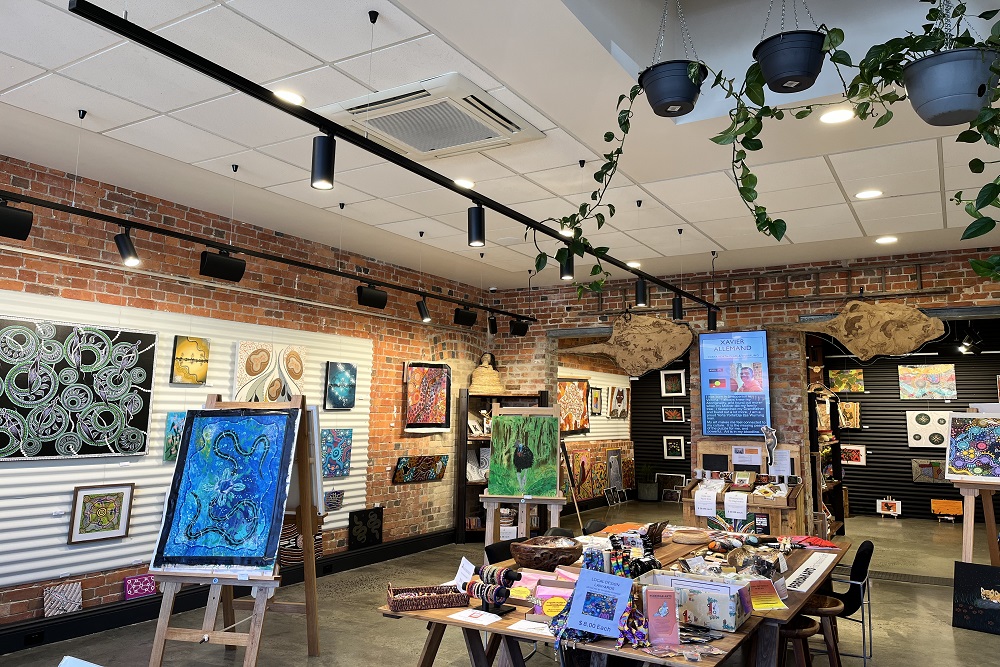
As far as unique Australian animals go, the platypus stands (or swims) apart.
The beak of a duck. The tail of a beaver. The venom of a reptile and fur that glows under ultraviolet light - there's nothing on Earth quite like it.
‘The platypus, or perridak in the Wadawurrung language, is a lovely being that's made of all different parts, said Sue Clark, Manager of Perridak Arts.
'When it came together, it was perfect,' she added.
Sue, who manages the gallery on behalf of the Ballarat and District Aboriginal Co-Operative (BADAC), sees the platypus as an apt symbol for the gallery and the artists it supports.
'We work with local First Nations artists, many of whom are survivors of the Stolen Generations,' she said.
‘These are people who were removed from their families and Country to live in Ballarat's orphanages.'
‘Despite this, we've developed a community here, which is like the different parts of the platypus coming together.’
In fact, recent BADAC surveys show that 39 different Aboriginal nations live within the community serviced by the organisation.
After offering art therapy as a way to help people process trauma and reconnect to their culture, BADAC decided to establish Perridak Arts on Mair Street.
'We'd have people approaching us with art they had produced at home, and not knowing what to do with it,' said Sue.
'As BADAC bought more and more of these pieces, it just made sense to set up somewhere to display and sell them,' she added.
The gallery, which opened in 2023 and was supported by $200,000 from the Victorian Government, has moved from strength to strength.
Representing a roster of around 70 local First Nations artists, Perridak Arts has sold more than $200,000 worth of art in the last 18 months - $120,000 of which has flowed directly back to the artists.

'The gallery is boosting the Aboriginal art industry and creating a lot of employment opportunities for our community,' said Sue.
'It's not just the artists who are earning income from their work, but also the staff working in the gallery.'
In the process, the gallery has become another outlet for BADAC to support self-determination amongst local First Nations People.
'BADAC is very clear that they want to develop industries and businesses that support us in a way that we continue to govern ourselves,' said Sue.
‘Whether that's through Perridak Arts, childcare centres or the Elders’ Independent Living Village, it’s a model that looks to support self-determination across all phases of life,’ she added.
That commitment to self-determination is evident in the relationship the gallery has with artists.
People can submit work, name their price for sale, and take it down whenever they wish.
All forms of art are welcome - from dot work to landscape paintings, emu eggs to weaves.
'The only criteria is that the artist be First Nations and have a connection to this area,' said Sue.
‘We are a very diverse Aboriginal community, and this enriches the artwork and traditional crafts on offer at Perridak Arts, as people draw inspiration from their own connection to Country.’

Less than 2 years into their residency on Mair Street, the gallery is becoming a firm favourite with visitors from all over the globe.
'I can't tell you how wonderful it is to phone an artist who wasn't sure if their art was even good enough to be displayed, to tell them their piece is now sitting in a living room in Boston,' said Sue.
'That's something we're keen to pursue further - sharing our work and culture with more tourists. And it becomes a two-way street. We've had people wanting to share their Maori culture with us, or even First Nations Canadian people wanting to share their heritage,' she added.
Looking back to the start of the journey, Sue is proud of what the gallery and the artists have achieved.
'It's quite amazing what this venture has done, and what a difference that $200,000 government investment has made. It has changed the lives of many people,' she said.
'We have a culturally safe space that supports self-determination for our artists. I think it's safe to say this venture has really hit the mark.’
Support for Perridak Arts forms part of our record investment of $45 billion over the past decade in projects and programs that are making rural and regional Victoria even better places to live, work, stay and play.
